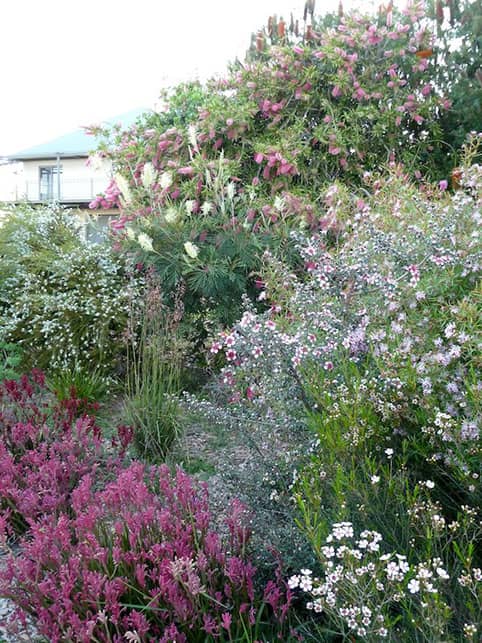When it comes to having a nice looking garden you have to have good Garden Edging in place. Not only does neat Garden Edging help define the different areas of your garden by showing a dividing line, but it can help keep those areas separate from each other. You don’t want your lawn encroaching on your flowerbed or veggie patch and you want to keep the mulch or gravel where you put it. But what is the right Garden Edging type to use? What edging material will do all that?
Plastic Garden Edging?
Over time, plastic garden edging breaks down and will eventually need to be replaced. Plastic garden edging may also be damaged by an errant wheelbarrow or lawn mower tracking over the top of it. You will probably get only one year, maybe two if you’re lucky, out of it before you’re replacing it.
Wood Garden Edging?
You have a few choices here like railway sleepers or pine logs. While these can be treated to survive in the elements, they will still rot, crack and splinter and eventually need to be replaced. Plus, you can’t do curves unless you purchase specially made pieces. Depending on the size of the sleepers or logs, you will need at least two people or more for installation and a trailer to transport it home.
Concrete Garden Edging?
Concrete garden edging can be more permanent than plastic or wood, but unfortunately, it can still crack and fade. Again, running over it with the lawn mower can result in either the concrete garden edging and/or your lawn mower being damaged if you’re not careful. Concrete garden edging is often bulky and always heavy, so you may need two people for installation.
Over time, pavers change colour or fade so if you need to replace one, the new one will look out of place amongst the old faded ones. Quite often, people will cement the pavers or bricks into place. This makes it challenging to replace any of them if they crack. If the cracking occurs in the cement underneath as well, then that broken section can dislodge or sink. In the long run, cement garden edging, be it straight cement, pavers or bricks, can become a problem and be really hard to replace.
Rocks as Garden Edging?
Rocks can give a nice rustic appearance to your garden but often require cementing in place so that they don’t move. Certain types of rocks can be fragile too. Slate or sandstone can easily chip, break or fall apart totally. Once again, a careless movement with the lawn mower could destroy that neat clean look you were after, not to mention the lawnmower blades or your legs if chips of stone start to fly.
Recycled Rubber Garden Edging?
While a more lasting product, recycled rubber garden edging can still break down in our harsh Australian climate and will eventually need to be replaced. Plus the crisp and clear lines will be harder to achieve as rubber isn’t known for clean straight lines that last.
Metal Garden Edging?
Metal garden edging has a nice clean look with pleasing straight lines throughout your Garden. Crisp and clear divisions between your gardens sections can be easily attained but the type of metal can cause problems once again.
Many metals like steel can rust, develop sharp edges or simply discolour over time. There are many different types of metal that can be used and aluminium is one of the best materials for garden edging as it doesn’t rust, discolour or get sharp edges. Read more on Metal Garden Edging, including information about installation and what products are available.
Aluminium Garden Edging!
Unlike all the other product types mentioned, aluminium is made to last! It doesn’t crack, fade, corrode, break down or develop sharp edges if designed right. If you run over this with the lawn mower, all you will see is sparks, not cracks, chips or damaged mower blades! Plus it can be flexible so if you want a curve or two, it can be easily achieved. Read more on Aluminium Garden Edging and the Link Edge system.
Link Edge Garden Edging
We think our Link Edge Garden Edging System is the ultimate in Garden Edging. Not only is it made from aluminium because of its longevity but it also is flexible so it can be used in every situation you could possibly want to use it in.
Link Edge is available in different lengths, heights, colours, strengths and shapes. Have an acidic soil or want to put it on a driveway or stone? Then use the heavy duty edging products, designed just for such situations.
You can bend Linkedge for curves or use a right-angled corner piece for precision corners. You can have a high profile using spike guides to help maintain rigidity or a lower profile to hide the edging if you desire. It can be used on hard or soft surfaces and even on slopes too! Just tell us what type of surface and we will advise you on the best way to secure it. The upper edge is curved so there are no sharp edges. That’s great for the safety of the kids when they are playing outside!
See the Aluminium article mentioned above for more information or go to the Products page to see what we have available. Our Ideas page has lots of pictures where you can see how others have used Link Edge. It might give you some inspiration for your own garden edging plans!
Call us now on 1800 454 657 to discuss your Garden Edging Ideas.
